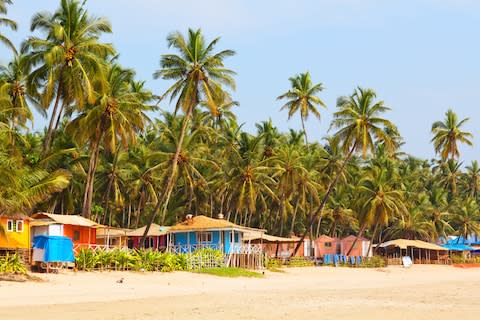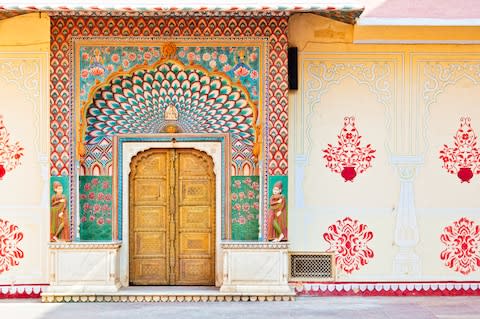The new cruise making India more accessible – and enjoyable – than ever before

At night, seen from outer space, the Earth sparkles with electric light; few areas of the world’s landmasses appear unlit. As they are mostly deserts, mountains, forest or frozen, their darkness is easy to explain.
A map of the world showing the shores visited by cruises would look much the same. There would be concentrations of light in the Caribbean and Mediterranean, but at some time of year, every ocean would be illuminated. Only one major patch of the globe would remain resolutely dim – the subcontinent of India. In terms of visitor attraction, this is far from desert, so the darkness here is hard to understand.
In many ways India would seem to be ideal cruising territory. By every measure of human senses, India is different. It is that travel rarity where nothing is bland, little is familiar and less has been homogenised. Its colours, tastes, sounds, landscape, wildlife, history, architecture and religions remain distinctly, vibrantly and exotically Indian. Yet it is a country that can appall as well as enthral and is approached by many first-time visitors with as much trepidation as excitement. Their preconceptions of finding distressing levels of poverty unfairly outweigh the reality of India’s thrilling sensory bombardment. Visions of squalor displace the actuality of India’s vitality and mystique.
Where those fears exist, cruising would seem to be an excellent way to allay them. The ability to dip into different bits of the country almost every day is like being given a tasting menu of an untried cuisine. Carefully curated escorted tours may not be hardcore exploration, but that’s the point. And so is the comfort of returning each evening to the reassuring sanctuary of a ship. It’s a textbook use of a cruise.

That, at any rate, was the thinking of Fred Olsen Cruise Lines. One of the smaller and more enterprising cruise companies, they have the deserved reputation for helping their passengers get as much from their time ashore as on board. Their vessels may be older than those in today’s glitzier fleets, but they belong to an era when the destination was the destination, not the ship. If a cruise is a perfect introduction to India, then Fred Olsen is the perfect outfit to run it.
And so it was that I flew to Mumbai to join the Olsen ship Boudicca, which was making the company’s first dedicated Indian cruise. Olsen had previously visited India on world cruises, and while this one started in Abu Dhabi and ended in Sri Lanka, it was the first to devote almost an entire two-week itinerary to the subcontinent. They called it Authentic India. Little did they realise just what Indian authenticity can entail.
My first foray was an early morning excursion to join the dabbawalas – the cadres of deliverymen distributing home-cooked lunches to city offices. India was immediately intoxicating. Even the tour bus was different, with the driver and his assistant in their own cab partitioned by glass from the rest of us. Indian city life flooded past the windows amid an unending accompaniment of chirruping horns and shrill whistles blown by policemen on point duty.
The temperature was already on its way to 30°C (86°F) and Mumbai was on its way to work: in white cars and black and yellow taxis; on motorcycles, men in front, girls riding pillion in saris and helmets; aboard lordly red buses, double-deckers, with open windows protected by bars, and on foot. Moving in shoals, pedestrians surged through any slit in the traffic. “We are very good at making organised chaos,” observed Lakshmi, our guide.

That night we observed a British cruising tradition and dressed for dinner. There were two formal nights when “collar and tie” were required; plenty of men went the whole hog and donned dinner jackets. On Boudicca it somehow seemed particularly appropriate. The ship may be Norwegian-owned but it could hardly be more British.
Everything is priced in pounds; the passengers are predominantly British, so is the entertainment and the food. There’s a British dish of the day and the menu even talked about a selection of “well done” vegetables, although I don’t think it meant quite what was implied; the food in the main dining rooms was actually rather good, imaginative without being pretentious. There is also a classy grill which charges a supplement.
Boudicca comes from cruising aristocracy. She was built in 1973 for Royal Viking Line, a company now extinct but in its day renowned for its luxury and long voyages. She was a grand tourer, a maritime Bentley of her era.
She creaks a little these days and, in her cabins especially, makes use of a lot of plastic laminates. She still has two sittings for dinner, with allocated tables, and guests need more electric sockets today than 46 years ago. But I suspect her age is of more concern to her maintenance crews than to her passengers. They, like her, tend to be veterans. They relish the fact that “she looks like a ship”, not a housing project, and that she is not enormous: she carries a maximum 880 passengers. I can’t think they miss the lack of an ice rink or climbing wall, though a newer ship would have more balconies. At the same time, the modern colours and fabrics used in Boudicca’s décor help belie her years.
We sailed south to Mormugao, the port for the former Portuguese colony of Goa. Our immigration chitties were inspected three times before we could leave the docks. Passing another imposing cruise terminal under construction, my tour went burrowing into history through an ancient landscape of forest and faith, of tropical bush and Christian missions, creeper-cloaked trees and Catholic churches.
With our driver relying on the three articles of faith for driving in India – good horn, good brakes and good luck – we were taken to two of Goa’s old capitals, Panjim and before that, Old Goa, known as “Rome of the East’” There stand two of the great Christian churches of the subcontinent. Both are part of an extensive Word Heritage site. The black granite Basilica of Bom Jesus has stood as a Baroque bulwark of Christianity since its consecration in 1605. It’s the resting place of the fervent 16th-century missionary, St Francis Xavier. His remains are kept in a silver casket. Nearby is the slightly later St Cajetan Church, domed, stuccoed and supposedly inspired by St Peter’s in Rome.
Panjim finally became a city and Goanese capital in 1843, decades after plague forced the abandonment of Old Goa. Panjim’s Latin Quarter, with its lanes of two and three-storey pastel painted houses, balconied and pantiled, is like being teleported into the back streets of Lisbon.
It was from Goa that I took an impeccably organised excursion to the Taj Mahal with two nights in Delhi. It cost £1,100, but for anyone who had never gazed upon that ethereal building it was exceptional value. The poet, Rabindranath Tagore, described the Taj as “a teardrop glistening spotlessly on the cheek of heaven”. How do you put a price on that?

Framed by the arch of the red sandstone gatehouse, the Taj is luminescent: it could be made of light and shadow as much as from cloud-white marble. Close to, you see it is a gigantic jewel box, adorned with exquisite bas-relief carvings, calligraphy and a finery of intricately inlaid semi-precious stones. The building, of course, is a mausoleum, and in a clammy octagonal chamber, patrolled by a small, bearded man blowing a referee’s whistle to keep the crowds moving, are two tombs. One for the Mughal emperor, Shah Jahan, who commissioned the building, and the other for Mumtaz Mahal, his favourite wife – he had five in all – to whom it was dedicated in a transcendent declaration of his love.
The Taj is a glory, but as with so much in India, it can be the incidental experiences that so enliven any travel – such as the train journey to the Taj from Delhi in “air-conditioned chair class” on the Gatimaan Express. At 8am Delhi’s Nizamuddin station thronged. A woman made continuous announcements over the PA, each separated from the next by what sounded like a blast on a trombone and the occasional apology: “Any inconvenience is deeply regretted.”
On the train an attendant balanced breakfast trays of omelette, chips and peas, while another made regular forays up the corridor with a mop. We raced across a dull plain of rice paddies and fields of maize at up to 75mph, though the bucking ride made it seem twice as fast.
We flew from Delhi to rejoin the ship in Kochi (formerly Cochin) in Kerala. The spice trade first attracted foreigners 700 years ago. Now, relics of that long history, big beaches and rural backwaters – a tropical wetland of canals, rivers and lagoons – make it one of the country’s most popular holiday destinations. Fred Olsen had its usual impressive range of well-priced excursions to make the most of our two days there.

This was to be our final stop in India. It added a certain symmetry to the trip as Kochi was where Vasco da Gama, the first European to reach India by sea, died in 1524.
Kochi is India in transition. It has a major shipyard, huge oil refinery, flourishing IT industry and its airport is entirely solar-powered. Yet elements of old India are still just to be seen. The cantilevered Chinese fishing nets, introduced in the 13th century, are gradually disappearing. Suspended from great, bell-shaped frames of bamboo, counterbalanced with strings of rocks, they dip gracefully into the water to the excitement of onlookers and flocks of expectant crows. Twenty nets once lined the shore, now there are five. “Designer” lorries, with cabs garishly decorated in a style similar to British barge art, are being superseded by characterless super-trucks, and the traditional hand laundry, where clothes are still bashed clean with stones, is down to an elderly staff of 15.
So should cruises go to India? Answer: emphatically Yes.
Indian cruises are doubly rewarding, both as a way of confronting prejudices about going to the country at all, and then for revealing its excitements. Boudicca’s cruise epitomised the situation. The ship wasn’t full, yet passenger interest could hardly have been higher.
And the Indian government wants cruises. At least part of the government does. It is a very Indian situation: in the same way that there is tension in the highest ranks of the Hindu deity between Vishnu, the preserver, and Shiva, the destroyer, different ministries are divided in their attitude to cruising.
India’s ministry of tourism (Vishnu) wants the country’s cruise business to double in three years and has asked for tax incentives to attract cruise ships. Yet Capt Mikael Degerlund’s humour was low when a heavy swell prevented us from landing at Vizhinjam, our final Indian port, and it took 24 customs and immigration officials seven hours to “clear” the ship to leave.
If anything, it is the bureaucracy that looks like keeping India a dark spot in the world cruise atlas for some years yet.

